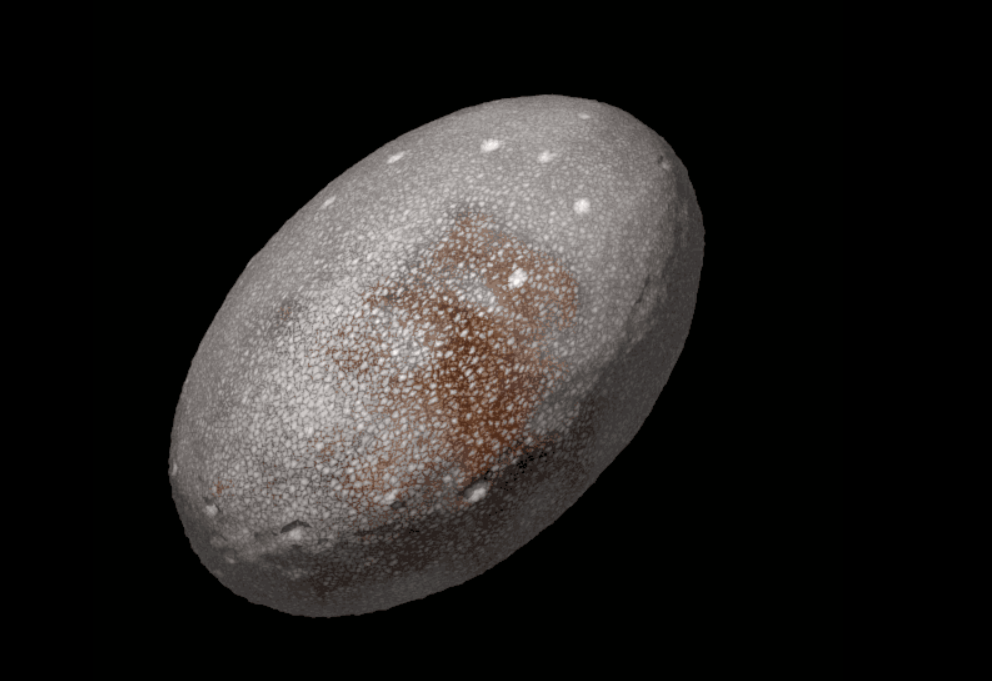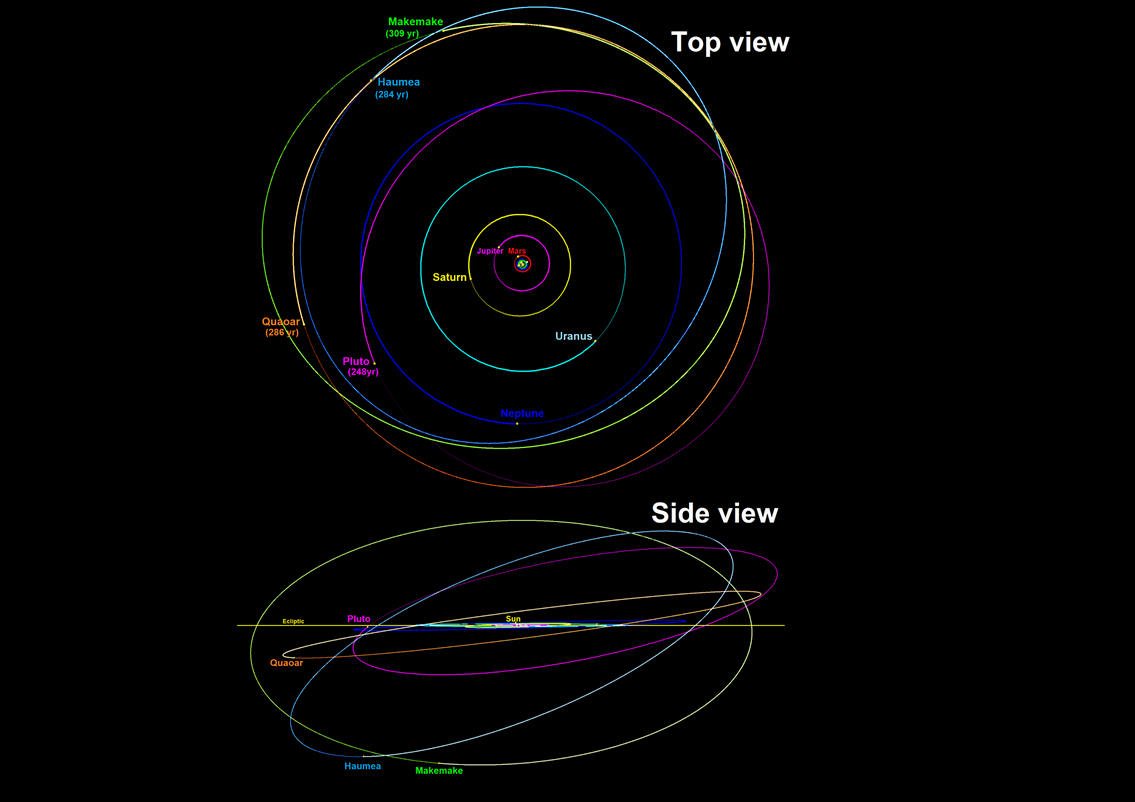
It only takes a glimpse into the night sky to realize our closest neighbor is the Moon, our own natural satellite. Traveling a distance of roughly 240,000 miles (386,400 kilometers) it takes around 3 days to make a one way journey to the Moon. The planets of our solar system are much further away, some more so than others so dwarf planets like Haumea take a long time to reach.
What Is Haumea?
Haumea is a fast spinning dwarf planet located in the trans-Neptunian Kuiper belt where it shares space with fellow dwarf planets such as Makemake, Pluto and Eris. Ceres, the other dwarf planet of our solar system, sits closer to the sun between Mars and Jupiter.
Roughly the same size as Pluto, Haumea’s discovery along with that of Eris and Makemake created a new classification of planets which saw Pluto demoted to Dwarf planet.
Haumea in terms of mass is about one-third that of Pluto, and 1/1400 that of Earth itself. Its shape has not been directly observed as yet but calculations from its light curve suggest it being a Jacobi ellipsoid. Its major axis is roughly twice as long as its minor.
Distance from Earth
Haumea ranges between 7.7 – 7.3 billion kilometers from Earth over the next few years but will reach its closest point to the planet on July 26th 2100. At that point it will be 5,489,394,503 kilometers from Earth.
Distance from the Sun
In order to understand just how far Haumea is from the Sun it is important to note that a single orbit around this star takes the dwarf planet 285 Earth years. An astronomical unit (AU) is equivalent to the distance between Earth and the Sun so when we consider Haumea is 43 AU from our solar system’s only star that is considerable. This equates to roughly 4,010,000,000 miles (6,452,000,000 kilometers) on average.
How Long Does Haumea Take to Go Around the Sun?
Almost 8 billion kilometers away from the Sun at its furthest Haumea as a result has a long path to take in orbit around this massive star. Haumea’s orbital period lasts roughly 285 Earth years which means that when it was last in the same region of our solar system as it is now in 2023 the world was very different. Events that happened at that time include:
- The birth of King George III of the UK
- Spain’s Royal Academy of History established by Royal decree of King Philip V
- The Treaty of Vienna is ratified

Haumea’s Structure
Gravity played a part in pulling together gas and dust to create the countless bodies in the Kuiper belt including of course Haumea. Although it is hard to be sure of the exact structure of a body so far from earth it is thought Haumea may be made of rock with an icy coating over it.
Surface
Little is known of the dwarf planet’s surface and it seems unlikely it has any form of atmosphere or magnetosphere. Essentially there is still a great deal to learn about this substantial dwarf planet.
Atmosphere
The vast distance between Earth and Haumea means that we know very little about this dwarf planet. At present we can not be sure if Haumea has an kind of atmosphere
Magnetosphere
Although Haumea is a long way from us scientists do not think that it has a magnetic field at this time although they can not be certain.
Does Haumea Have Moons?
Haumea to date according to NASA has two known moons. These are Namaka (Hawaiian water spirit), its inner moon, and Hi’iaka (patron goddess of Hawaii), the outer moon. They are named for two mythological daughters of Haumea, the dwarf planet’s namesake.
This dwarf planet is also the only known Kuiper belt object to have rings. This was determined when Haumea passed in front of a star in 2017.
History of the Observation of Haumea
Haumea is so far away from earth that unlike 7 of our solar system’s planets we can not see it with the naked eye. Even with the advent of telescopes it would take hundreds of years to first image and then discover the existence of Haumea.
There is some contention regarding who actually discovered Haumea. It was either a team made up of Mike Brown, Chad Trujillo, and David Rabinowitz or José Luis Ortiz Moreno and his team at the Instituto de Astrofísica de Andalucía at Sierra Nevada Observatory in Spain.
The Mike Brown team were reviewing images captured on October 21st 2003 using the 1.2 m Samuel Oschin Schmidt telescope at Palomar Observatory, California. It was over a year after the images were taken that this group on January 5th 2005 discovered the presence of Haumea as well as other planetary objects such as Makemake (two days earlier) and Eris (two days earlier).

The team did not immediately report their findings as they wanted to observe more about the potential orbit before going public. On July 27th 2005 however Ortiz’s team announced the discovery of Haumea.
Initially Brown accepted that the Spanish team may have beat them to the punch in the discovery but was to discover that the Spanish observatory had accessed his observation logs the day before they announced discovering Haumea.
Although the Spanish observatory is credited as the origin of the discovery because of reporting standards being met, neither group has been given credit for the discovery because of the possible contentious nature of Spain’s discovery.

It should be noted that an independent committee settled on the name for the dwarf planet which just so happened to be the name suggested by Caltech. This may have been a concession to avoid a scandal in the community although Spain’s suggestion would not have been suitable anyway.
Mike Brown’s team rushed to announce their discoveries of Eris and Makemake soon after Spain beat them to punch over Haumea. They were likely worried the same may happen with these dwarf planets and wanted to avoid this if at all possible.
Haumea was chosen as the official name in honor of the Hawaiian matron goddess of Hawaii. Associated with fertility and childbirth Haumea did fit traditional naming practices for Kuiper belt objects. The tradition established by the IAU was that Kuiper belt objects be named in honor of creation deities of which Haumea was suitable. Spain’s suggestion of Ataecina the goddess of the Spring would not have been suitable.
Space Exploration
The New Horizons spacecraft first observed Haumea from afar in October 2007, January 2017, and finally May 2020. The spacecraft’s outbound trajectory allowed for observations of Haumea at high phase angles which would not have been possible from Earth. This helped in the discovery of the light scattering properties and phase curve behavior of the dwarf planet’s surface.
How Long Does It Take to Get to Haumea?
In consideration for a future mission it was Joel Poncy and colleagues who calculated that a flyby mission to Haumea could take upwards of 14.25 years to complete using a gravity assist at Jupiter. Due to varying distances from Earth at any time, optimum dates for a future mission launch are November 1st 2026, September 23rd 2037 and October 29th 2038.
Final Thoughts
The quickest we could likely make it to Haumea for a flyby is a little over 14 years but if we were to try and establish orbit the journey would take much longer. At present this is not a priority so estimates are not being seriously considered. What we do know is that to enter orbit around any body in space we have to travel slowly enough to be captured by the body’s gravity. Over such a vast distance this would require low speeds making the journey likely longer than experts would be willing to undertake at this time.
